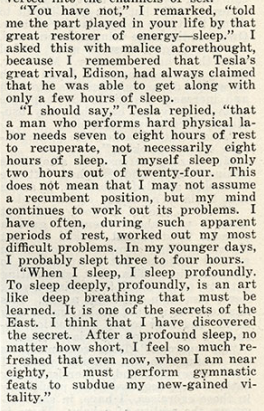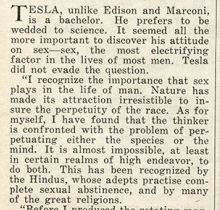
Interview with Nikola Tesla about his sleeping habits. SOURCE: Physical Culture, 1935.
Nikola Tesla was born on July 10, 1856 in present-day Croatia. The fourth of five children, he started being interested in electricity while attending high school.
Tesla was a focused student. Using his eidetic memory, he was able to do complex math in his head and speak eight languages. While at the Austrian Polytechnic, he "never missed a lecture, made the highest grades possible and started a Serbian culture club." (SOURCE: Tesla Universe, 2020.)
His single focus would follow him as he got older. He worked every day from 9am to 6pm. He would stop for dinner and resume working until 3am.

Interview with Nikola Tesla about his sleeping habits. SOURCE: Physical Culture, 1935.

Interview with Nikola Tesla about his views on relationships. SOURCE: Physical Culture, 1935.
Tesla started working at the Paris location of the Continental Edison Company in 1882, where he gained a lot of experience with electrical engineering. Then he was transferred to the US to work for Edison Machine Works in New York City.
"In June 1884, after the well-known mishaps (theft of the train ticket and personal assets) Tesla arrived in New York with only four cents in his pocket.
Thanks to the exceptional recommendation by [Edison's associate Charles] Batchelor and a successfully performed test given by Edison (repair of dynamo machines at the Oregon ship) Tesla was employed with Edison Machine Works. To this twenty-eight-year old enthusiastic expert Edison gave a very delicate job of redesigning and improvement of dynamo-machines produced in his factories for the ever-increasing market of these devices. The direct current electrification era had begun in the first place with great towns such as New York."
"[Tesla] was engaged on engineering and constructing tasks, in the first place to design direct-current motors and generators (dynamo-machines) used to feed arc lamps and other devices. He calculated the sizes and coils of stators and rotors, as well as the power of machines. He also tested each redesigned or new machine. His projects comprise several types of dynamo-machines (Gramme, Schuckert) predominating at that time. The basic parameters of his own 'Tesla E.L.C. Machine' are also given. Aside of the calculations of new machines, he also reconstructed the existing ones. Noteworthy is also his ability to combine the existing solutions in order to obtain the characteristics (power, current etc.) required for particular purposes."
-Radmilo Ivanković, Dragan Petrović. Nikola Tesla: Notebook from the Edison Machine Works 1884-1885
After six months at Edison Machine Works, Tesla quit and eventually became a critical part of Westinghouse's victory in the War of the Currents.
SOURCE: Discovery UK, 2018